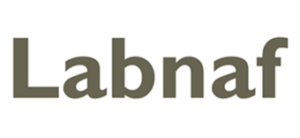As a Chief Architect, why should I start with Labnaf?
Labnaf unifies more than 20 architecture and strategy standards into one actionable workflow for visualizing your enterprise and for driving transformations.
It brings productivity, consistency and cross-discipline collaboration by merging these standards into one single process, modeling language, repository structure, and software.
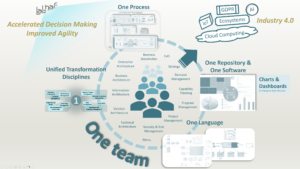
Transformation disciplines have been unified to support the transformation process.
Cross-discipline collaboration throughout the entire process of driving transformations
Know who uses and and delivers what, how, where and with what.
A major problem with isolated strategy and architecture disciplines is that they don’t always clearly describe the value that they bring to the organization, and especially to other disciplines involved in transformations.
- What type of content does each discipline exactly deliver?
- For whom?
- For what purpose?
- What questions does each deliverable answers? How can we take better decisions using this?
- Where and how do we store, organize, share and secure this content?
- How do we make this understandable and useful for different audiences?
- How do we distribute, enrich, validate and normalize this content?
- What is the exact tool support?
- Where is this clearly documented?
- Where are the training courses explaining how these disciplines should working together?
- How does this contribute to the realization of the target business outcomes?
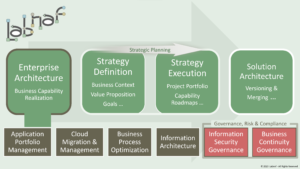
Visualize and diagnose you enterprise
PowerPoint slides, or equivalent, communicate your ideas to non architecture savvy stakeholders.
Models make your strategy and architecture unambiguous and traceable. They enable the creation of charts and reports.
Charts and reports communicate the state of the union.
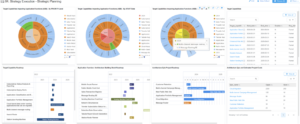
Focus on business outcomes
Ensure your transformation investments implement your defined strategy.
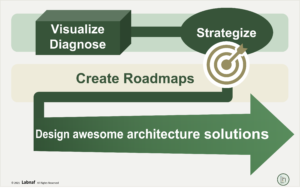
All-in-one
Labnaf brings productivity, consistency and cross-discipline collaboration by merging and extending standards into one single process, modeling language, scalable repository structure, and software.
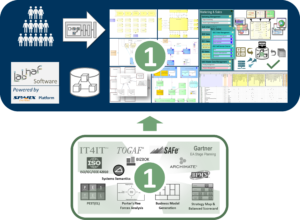
Turnkey solution
Labnaf is ready to go.
You can start modeling, visualizing and driving enterprise transformations from day one.

What is important (and widely overlooked) is to have a clear and actionable process for driving transformations, end-to-end.
- With clear flows of viewpoints, charts and reports for all architecture and strategy roles throughout the process.
- With useful and flexible enterprise visualizations
- With a single language and metamodel that is expressed and configurable using the end users’ modeling language itself
- With a single repository and tools capable of managing complexity for small or very large organizations
- With loads of productivity tools to eliminate manual tasks, to enrich and to distribute the shared and secured repository content, to normalize the content organization etc.
- With the ability to import content and translate any language to and from any other language, including Labnaf
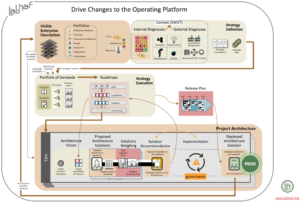
Labnaf Unified Transformation Process
A simple scenario
Let’s see how the Labnaf process is used for driving transformation in a Bus Operating Company (let’s call it BOPCO).
The Enterprise Architect provides some high-level description of the enterprise. She or he adds a lot of operational information describing how BOPCO works.
If the organization’s size is medium to very large, she/he get help from specialized architects who populate, curate, relate and present portfolios of elements.
These architecture elements include information, people, enterprise functions/business capabilities, processes, applications, equipment, technologies, material etc.
A scalable language is used for populating these portfolios, to manage complexity and separates levels of detail.
The Solution Architect(s) also populate(s) the visible enterprise description by adding technical information.
Charts are used to summarize the information and to help taking the right decisions.
The Strategist analyses the current business context, from internal and external perspectives.
Then she or he reviews the value propositions, business models and SMART goals.
The Business Architects determines how the goals impact value streams.
And more precisely how the goals impact enterprise functions used by these values streams.
The Enterprise Architect identifies the target capabilities needed to optimize the value streams.
That leads to a target capabilities roadmaps.
A program manager, assisted by architects assigns target capabilities to projects.
And that leads to a roadmap of projects.
For each project (that is changing the enterprise operating model)
- A Solution architect defines an architecture solution that realizes the target capabilities.
- If the solution gets approved, then the solution architect adds the solution to the visible enterprise description.
- Then the solution gets implemented.
- And at some point, the solution will be running in production.
- Then the solution architect needs to update the AS-IS situation in the visible enterprise description.
There are or course many more roles involved.
The transformation process is described in several formats including flows of viewpoints
- Where each type of view (viewpoint) answers some defined and meaningful questions.
- So we understand
-
- Why we need such views
- Who (role) provides input
- Who uses the output
- Which language constructs are used in each type of view
Embedded Governance
You can, just as a few examples,
- Configure you own sets of mandatory views along with their dependencies
- Calculate architecture documentation completeness and present results in predefined dashboards
- Govern strategy and architecture delivery using predefined charts and dashboards specific to each stage in the transformation process
- Automated information distribution to business and IT stakeholders
Content Optimization
You can
- Automatically import information periodically or on demand
- Define initial value calculations when I create new elements
- Schedule automatic content refactoring, normalization and validation
- Cascade value calculations. Ideally define these calculations using the same modeling language.
- Generate diagrams automatically
- to reduce time and costs,
- and to get complete and consistent diagrams that are not dependent on the author.
Dashboards, Charts and Reports (Periodically or On Demand)
You can
- Provide summary and C-level views using predefined and extendable charts and dashboards
- Define tabular report templates (for Excel generation). Ideally define these templates using the same modeling language.
- Provide detailed reports, including consolidated matrices, using Excel report generation
- Generate principles and standards documents and re-use those in my RFPs
- Generate solution architecture documents based on controlled model content
Automatic Task Scheduling (e.g. nightly)
You can automate many manual task like for example:
- Data import/export/synchronization
- Calculation
- Diagram generation
- Excel generation
- Word, PDF and RTF generation
- HTML generation
- Content normalization and validation with error report distribution
- Backups…
Framework Tailoring (Language, metamodel, viewpoints and their dependencies, toolboxes, diagram types…)
- A SDLC (DEV, TEST, PROD) environment to quickly customize my language, metamodel, toolboxes and diagram types in a few clicks
- Straight through metamodel customization, because my metamodel evolves quickly, especially in the beginning
- A practical metamodel that makes sense (derived from transformation process and systems semantics from the language itself)
- Ease metamodel evolution and readability.
- Metamodel expressed using the end user language (metamodel and documentation are now the same thing)
- Change metamodel in two clicks
- Automatically identify invalid connectors in existing model
- Run a language transformer tool to adapt invalid connectors
Additional language transformation capabilities
- Import models from other tools and languages
- Adapt element types, connector types, diagram types, tagged values, tag grouping, default tag grouping status and default element sub-diagram types in my existing or imported models
